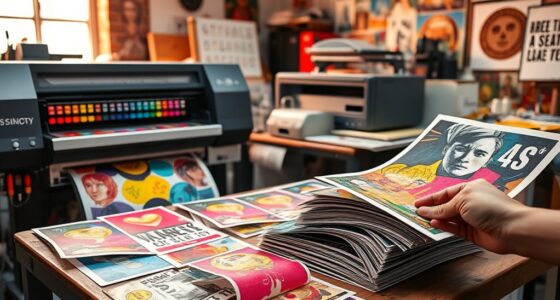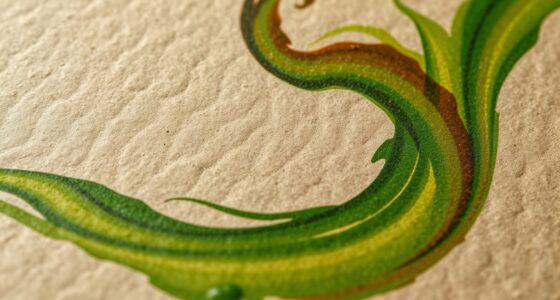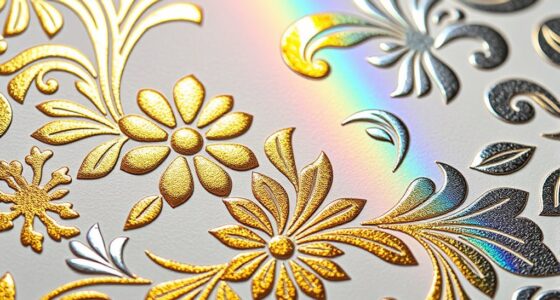When choosing the right paper stock, consider how texture, weight, and mood align with your project’s goals. Smooth papers work well for crisp images and professional looks, while textured or rougher options add tactile interest and sophistication. Heavier papers feel more substantial and luxurious, ideal for invitations or covers, while lighter ones are budget-friendly for flyers. Decide what mood you want to create—warm and inviting or sleek and modern—and explore how the right combination can elevate your print materials.
Key Takeaways
- Match paper texture to the desired tactile and visual impact, considering whether a smooth, textured, or glossy finish best suits your project.
- Select paper weight to balance durability, cost, and the message’s tone, opting for heavier stocks for premium feel or lighter ones for economy.
- Consider the mood you want to evoke; warm, soft textures create coziness, while bright white or cool tones convey modernity and precision.
- Ensure compatibility between paper texture and printing techniques like embossing or letterpress for optimal quality and depth.
- Prioritize eco-friendly options, such as recycled or FSC-certified papers, to align with sustainability goals without sacrificing aesthetic appeal.

Have you ever wondered how the choice of paper stock can impact the overall look and feel of your printed materials? The paper you select isn’t just a background; it’s a essential part of your design that influences perception and effectiveness. When considering paper options, think about texture, weight, and mood, as these elements shape how your message is received. The right paper can elevate your project, while the wrong choice can undermine it, making careful selection indispensable.
Start by evaluating the texture of the paper. Smooth papers are ideal for crisp, clean images and professional looks, especially for business cards, resumes, or high-end brochures. Conversely, textured papers add tactile interest, giving your materials a distinctive feel that can evoke sophistication or creativity. For example, a rougher, linen-like texture may suit artisanal branding, while a glossy finish enhances vivid photographs. Your choice of texture also ties into printmaking techniques; certain textures work better with specific printing methods, such as letterpress or embossing, which can add depth and visual interest. Keep in mind that textured papers often require more delicate handling during printing, and some printing methods might not be suitable for all textures.
Texture choice influences print quality and tactile appeal, enhancing branding with careful selection of paper surface and printing techniques.
Weight is another essential consideration, affecting both durability and visual impact. Heavier papers tend to feel more substantial and luxurious, perfect for invitations, covers, or presentation materials. Lighter papers are more economical and suitable for flyers or handouts that don’t need to last long. Your choice of weight can also influence the environmental impact of your project. Lighter papers generally use fewer resources in production, reducing the carbon footprint, but may not provide the durability some projects require. Choosing eco-friendly paper options, such as recycled or FSC-certified stock, can further reduce environmental impact without sacrificing quality. When selecting paper weight, balance your aesthetic goals with sustainability, ensuring your project aligns with your values.
The mood conveyed through your paper choice is often overlooked but essential. Soft, warm-toned papers can create an inviting, cozy feel, perfect for wedding invitations or boutique branding. Bright white or cool-toned papers evoke modernity and precision, suited for tech companies or minimalist designs. The tactile qualities and visual tone of your paper influence how your audience perceives your message. Additionally, consider how different printmaking techniques interact with your chosen paper. Some techniques, like letterpress or foil stamping, add elegance and tactile richness, complementing specific paper textures and weights. Selecting the right paper stock is a strategic decision that combines aesthetics, function, and environmental responsibility, shaping the overall mood and impact of your printed materials.
Frequently Asked Questions
How Does Paper Texture Affect Print Quality?
Paper texture directly impacts print quality by influencing clarity and detail. A smooth texture ensures sharp, crisp images and text, making details stand out. An embossed finish adds tactile appeal, enhancing visual interest and perceived quality. Conversely, rough textures can create a more artistic or rustic feel but may reduce print sharpness. You should opt for a smooth texture for precise prints and an embossed finish when you want a luxurious, textured effect that elevates your design.
What Are the Environmental Impacts of Different Paper Stocks?
The environmental impacts of different paper stocks can be enormous, shaping the future of our planet. By prioritizing sustainable sourcing and practicing recycling diligently, you reduce deforestation and lower carbon footprints. Using recycled paper drastically cuts waste and conserves resources, while opting for sustainably sourced materials guarantees forests remain healthy. Your choices matter, influencing ecosystems and climate change. Embrace eco-friendly options to make a significant, positive impact on the environment.
How Can I Match Paper Weight to My Project Budget?
To match paper weight to your project budget, consider print cost considerations carefully. Heavier papers often cost more, so opting for a lighter weight can be more budget friendly. Look for options like 70-80 lb text weight, which balances quality and affordability. You can also explore recycled or uncoated papers that tend to be cheaper, helping you stay within your budget without sacrificing overall project impact.
What Are the Best Paper Options for Outdoor Use?
Did you know that UV coated paper can last up to five years outdoors? For outdoor use, you should opt for water-resistant coatings and UV coated paper, which resist moisture, UV rays, and fading. These options keep your materials durable and vibrant even in harsh weather. Choose water-resistant coated paper for added protection, ensuring your outdoor projects stay intact and look professional, no matter the conditions.
How Does Paper Stock Influence Overall Brand Perception?
Your paper stock directly impacts brand perception by reinforcing branding consistency and enhancing the tactile experience. High-quality, textured paper feels premium, making your brand appear more trustworthy and sophisticated. Conversely, cheaper or flimsy paper can suggest lower quality, damaging your image. Choosing the right paper stock shows you care about details, helping your audience connect with your brand through both visual appeal and tactile engagement.
Conclusion
Now that you know how texture, weight, and mood influence your paper choice, are you ready to pick the perfect stock that truly reflects your message? Remember, the right paper doesn’t just carry your words — it elevates your entire project. So, trust your instincts, consider your audience, and don’t be afraid to experiment. After all, isn’t the tactile experience just as important as the content itself?









